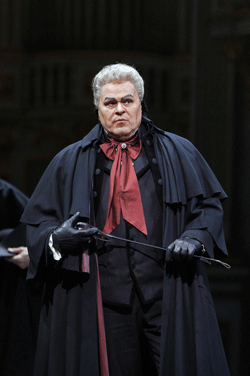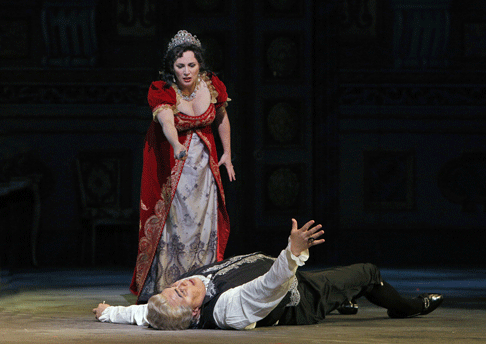Patricia Racette is a powerful lyric soprano who like all great singers possesses a unique voice, its signature sound is the interplay of excited overtones. This excitement, these vocal nerve endings possess all of these Puccini victims, and transmit their vulnerability, their super human strength, their beauty, above all a melodramatic feminine humanity that has endured one full century now, and will still be real as long as there may be humankind.
Mme. Racette is a committed and skilled actress, but more so she is an honest artist. Her voice is in its prime, as it has been and will be for some time. To her voice she adds intelligent and straight forward musicianship that ties us securely to her character, thus we are held captive by her very presence even in the numerous pantomimes when Tosca does not sing, but silently observes the murdered Scarpia, and approaches the dead Cavaradossi. It is her rock solid artistry in service to real human drama that seduces us.
 Mark Delavan as Scarpia
Mark Delavan as Scarpia
If in the first act la Racette does not find the persona of a jealous diva, one we suspect we would find in the more usual spinto voiced Tosca. Racette does persuade us that she is a woman in love, and a woman vulnerable to powerful men, fiery revolutionaries and corrupt functionaries. At the opera’s end, finally trapped by these forces she frees herself in her dramatic leap. And what a leap it was — in spread eagle form, the euphoria of liberation. Patricia Racette is a bona fide diva.
These days in the War Memorial when Nicola Luisotti is on the podium individual performances are tied to the pit, an aria is really a duet, and such was the case last night in a stunning delivery of Vissi d’arte, the maestro in his euphoria of pillaging every possible tremor of feeling from a very willing orchestra, the soprano but a part of his larger whole. Scarpia and his henchmen plotting to ensnare Angelotti, Cavaradossi and Tosca captured with a musical force nearly equal to Verdi’s Otello, culminating in a Te Deum that had much more to do with Luisotti and Puccini and the joy of sheer power than with Scarpia.
The maestro plumbs a depth of sound and searches color in the orchestral voice, and only then pushes forward the flow of musical action. This creates a stop and go rhythm of often extreme tempos, fast or slow. Last night in the second act in particular these fluctuating tempos musically riveted us to the interplay of Tosca and her tormentor, and in the third act bound us to her nervous fear.
Tosca’s tormentor, the Scarpia of bass baritone Mark Delavan, was not driven by the pure, unadulterated lust that usually drives this politically privileged baron. Instead Delavan toyed with his power, the seduction of Tosca was played as a game with himself, as proof of his privilege, not as release of his unbridled libido. Delavan found a humanity in Puccini’s villain that was supremely ugly, more offensive than exercising sexual prowess. Utilizing the inherent beauty of his now mature voice he thoroughly embodied the bloated, entitled political aristocracy. This was Mark Delavan as an estimable artist. We would have expressed our appreciation had he stayed around for the bows at the end of the opera.
 Mark Delavan as Scarpia and Patricia Racette as Tosca
Mark Delavan as Scarpia and Patricia Racette as Tosca
Against all this, a quirk of impresario privilege, San Francisco Opera general director David Gockley cast an Adler Fellow as the artist and revolutionary tenor Cavaradossi. Young tenor Brian Jagde held his own to some degree, while definitely out of his league. He possesses a young, vibrant voice and secure high notes. He lacks the squillo that would make his voice Italianate, nor is he yet schooled in the style. There was the occasional catch that sometimes might have been the tenorial sob and other times might have been a momentary catch in an overburdened voice. While Mr. Jagde was abundantly rewarded by the crowd for his performance the fact remains that the War Memorial is not an appropriate stage for a young singer to break in a role.
Supporting roles were superbly cast. Christian Van Horn made a detailed and very present Attavanti who set the stage for a revolutionary tone to Puccini’s opera. Tenor Joel Sorensen etched a sniveling Spoletta, brutalized by Scarpia and Adler Fellow Ao Li was right-on as Sciarrone. Not to overlook the low key, masterful, not too intrusive Sacristan of Dale Travis.
The production was the 1997 remake of the 1923 production, and it is time to send it to the dump — its nostalgia has been lost and it is boring. The staging of this umpteenth revival was however masterfully managed by Jose Maria Condemi. Hopefully Mr. Condemi will write a book to reveal the now secret (maybe best left untold stories) of staging these San Francisco Opera Tosca follies.
Michael Milenski
Cast and Production
Floria Tosca: Patricia Racette; Mario Cavaradossi: Brian Jagde; Baron Scarpia: Mark Delavan; Angelotti: Christian Van Horn; Spoletta: Joel Sorensen; Sacristan: Dale Travis; Sciarrone: Ao Li; Jailer: Ryan Kuster; Shepherd Boy: Ryan Nelson-Flack. San Francisco Opera Orchestra and Chorus. Conductor: Nicola Luisotti; Stage Director: Jose Maria Condemi; Production Designer: Thierry Bosquet; Lighting Designer: Christopher Maravich. San Francisco War Memorial Opera House. November 16, 2012.
![Brian Jagde as Cavaradossi and Patricia Racette as Tosca [Photo by Cory Weaver courtesy of San Francisco Opera]](http://www.operatoday.com/03--Tosca.gif)

